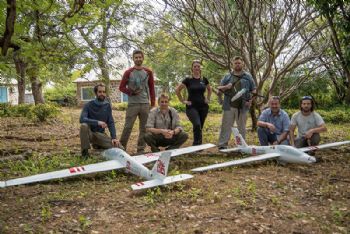
The University of Bristol (
www.uwe.ac.uk) and the Bristol Zoological Society (BZS) are pioneering a new approach to wildlife conservation, involving machine-learning and drone technology, which could impact wildlife conservation projects world-wide.
With funding from the Cabot Institute for the Environment, BZS and the EPSRC’s CASCADE grant, a joint team flew to Cameroon in December to trial the use of drones, sensor technologies and deployment techniques to monitor populations of the endangered Kordofan giraffe in Bénoué National Park.
Caspian Johnson, Conservation Science Lecturer at BZS (
www.bristolzoo.org.uk), said: “Bénoué National Park is very difficult to patrol on foot, and large parts are virtually inaccessible, presenting a huge challenge for wildlife monitoring.
"What is more, the giraffe are very well camouflaged and often found in small transient groups.”
Keen to identify the best strategy for airborne wildlife monitoring, BZS approached Matt Watson at the University of Bristol’s School of Earth Sciences, and Tom Richardson at the University’s Aerospace Department.
They were able to draw on successful collaborations using drones to monitor and measure volcanic emissions to begin developing a system for wildlife monitoring.
Dr Watson said: “On the surface, this might seem relatively easy but imagine a heavily wooded area the size of Greater London (1,600km
2), in which you are trying to find an estimated population of just 20 to 30 Kordofan giraffe.”
Dr Richardson said: “It is likely that we will need more than one type of drone and several different sensors to allow us to operate 24hr a day and throughout the year.
"Modern multi-spectral cameras combined with machine learning and high-performance vehicles will need to be fully automated to cover an area of this size.
"Combine that with remote constrained field operations and we have an interesting set of engineering problems to tackle.”